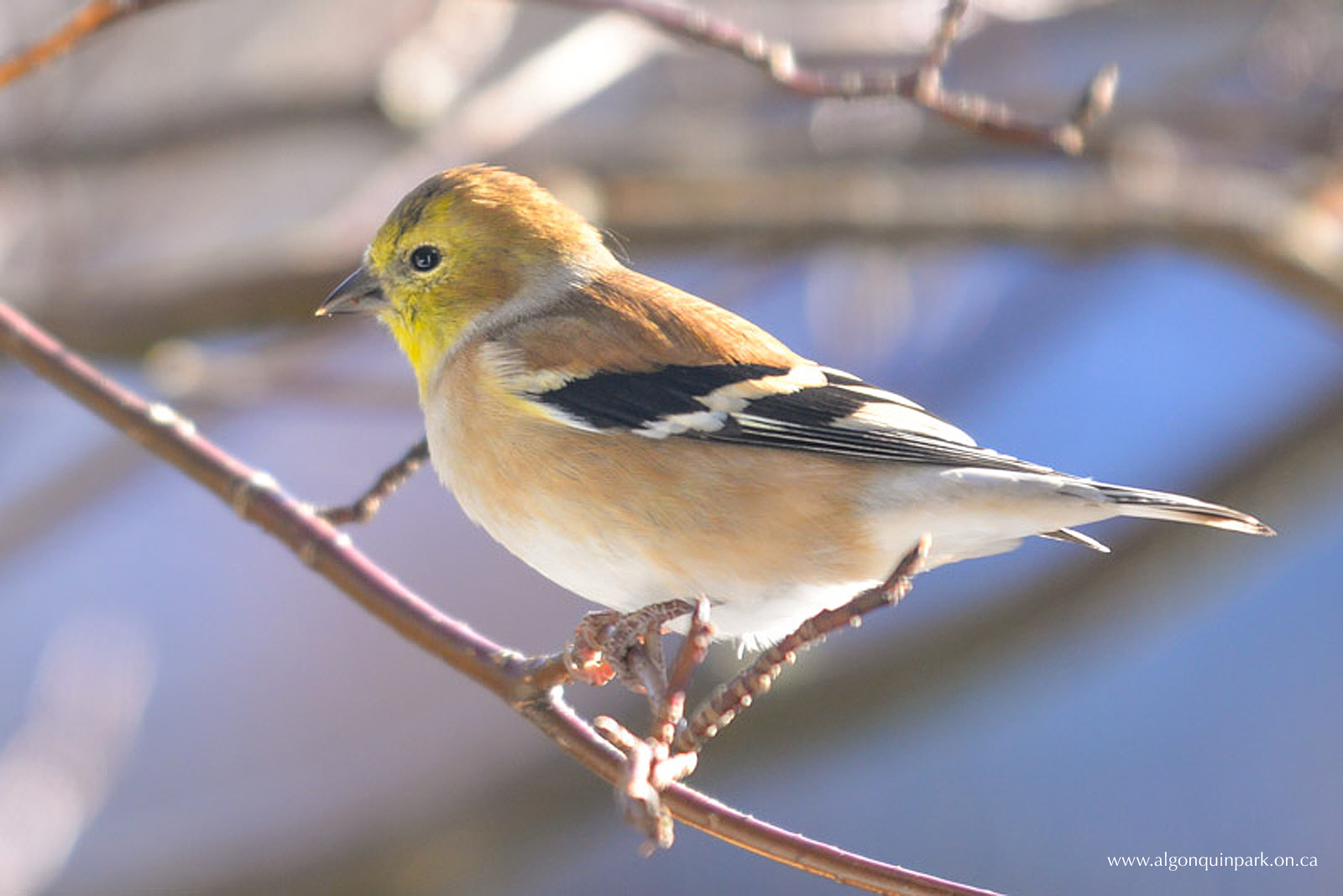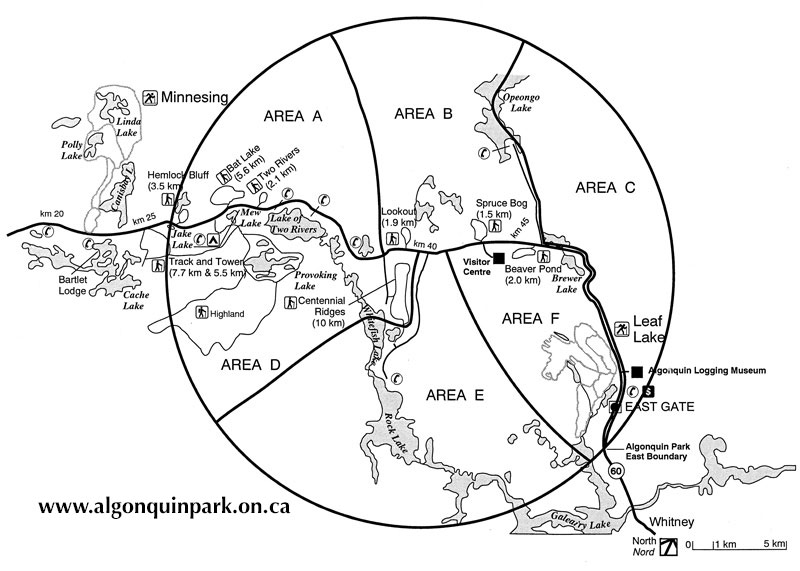Events Calendar
Current Weather
January 6, 2020
Christmas Bird Count Results 2019
Sixty-six observers undertook the 46th Algonquin Park Christmas Bird Count on Saturday, December 28, 2019. Weather conditions were very good for seeing birds. Temperatures ranged from -3°C to -1°C. The southwest wind reached 10-20 km/h occasionally but it was calm in the woods. The sun persisted all day. Maximum snow on the ground was about 25 centimetres but much less under conifers, making walking relatively easy. All lakes were ice-covered but the Madawaska River was mainly open. Winter finches had a good variety but numbers were lower than some previous years which had a similar huge cone crop.
A record high count of 942 American Goldfinches were observed on the 46th Algonquin Park Christmas Bird Count. American Goldfinch photo in Algonquin Park by Ken Morrison.
Overall Results
- Number of Observers: 66
- Total Species: 33 (average is 27)
- Total Individuals: 5,894 (average is 4,579)
- Birds per Party Hour: 37 (average is 25)
Highlights
Unusual Species for the Count:
- Belted Kingfisher: 2
- Sharp-shinned Hawk: 1
- American Crow: 1
High Count:
- Belted Kingfisher: 2 (previous high 1);
- American Goldfinch: 942 (previous high 932)
Low Count:
- Boreal Chickadee: 2
All Species Observed on the 2019 Algonquin Park CBC
- CW= observed during Count Week
- Bald Eagle 2
- Sharp-shinned Hawk 1
- Wild Turkey 6
- Ruffed Grouse 68
- Spruce Grouse 1
- Rock Pigeon CW1
- Barred Owl 1
- Belted Kingfisher 2
- Downy Woodpecker 27
- Hairy Woodpecker 29
- Black-backed Woodpecker 4
- Pileated Woodpecker 11
- Northern Shrike 1
- Canada Jay 25
- Blue Jay 472
- American Crow 1
- Common Raven 107
- Black-capped Chickadee 1097
- Boreal Chickadee 2
- Red-breasted Nuthatch 611
- White-breasted Nuthatch 16
- Brown Creeper 48
- Golden-crowned Kinglet 228
- American Tree Sparrow 4
- Dark-eyed Junco 14
- Snow Bunting 1
- Pine Grosbeak 4
- Purple Finch 647
- Red Crossbill 194
- White-winged Crossbill 398
- Common Redpoll 67
- Pine Siskin 822
- American Goldfinch 942
- Evening Grosbeak 14
- Eagle sp. 1
- Woodpecker sp. 3
- Crossbill sp. 18
- Finch sp. 5
- Total Number of Species 33
- Total Number of Individuals 5,894
- Number of Observers 66
- Total Party Hours 158.5
- Total Distance (km) 550.9
- Birds Per Party Hour 37.2
- Average Number of Birds per Observer 89.3
Thanks to all the participants and those who helped organize and undertake
the count this year.
Ron Tozer
Algonquin Park CBC Compiler
Additional Bird Sightings
Please send us any bird sightings you've had in the park, even of common birds, as they assist us in documenting Algonquin Park's bird life.
Birders reporting records through eBird are encouraged to share their lists with the Algonquin Park Bird Records account (APPbirds).
Christmas Bird Count Circle in Algonquin Park
Bird count volunteers follow specified routes through a designated 24 kilometre diameter circle (shown below) and count every bird they see or hear with a 24 hour period. This provides an early winter bird census for Algonquin Park and combines with data from other counts in Canada, the United States, and many other countries. In Algonquin Park, the 24 kilometre circle is centred on the intersection of the Rock Lake Road and Highway 60.
What is the Christmas Bird Count?
The Christmas Bird Count (CBC) is a long-standing program of the National Audubon Society, with over 100 years of citizen science involvement. It is an early-winter bird census, where thousands of volunteers across the US, Canada and many countries in the Western Hemisphere, go out over a 24 hour period to count birds.
How is the Christmas Bird Count conducted?
Count volunteers follow specified routes through a designated 24 kilometre diameter circle, counting every bird they see or hear all day. It’s not just a species tally—all birds are counted all day, giving an indication of the total number of birds in the circle that day. If observers live within a CBC circle, they may arrange in advance to count the birds at their feeders and submit those data to their compiler. All individual CBC’s are conducted in the period from December 14 to January 5 (inclusive dates) each season, and each count is conducted in one calendar day.
Why was the Christmas Bird Count started?
The first CBC was done on Christmas Day of 1900 as an alternative activity to an event called the “side hunt” where people chose sides, then went out and shot as many birds as they could. The group that came in with the largest number of dead birds won the event. Frank Chapman, a famed ornithologist at the American Museum of Natural History and the editor of Bird-Lore (which became the publication of the National Association of Audubon Societies when that organization formed in 1905) recognized that declining bird populations could not withstand wanton over-hunting, and proposed to count birds on Christmas Day rather than shoot them.
Is the Christmas Bird Count useful?
Absolutely. The data collected by observers over the past century allow researchers, conservation biologists, and interested individuals to study the long-term health and status of bird populations across North America.
Related Information
Reserve your developed or backcountry campsite for your next visit.
Share your passion for Algonquin Park by becoming a member or donor.
Special regulations for Algonquin's special fishery.











